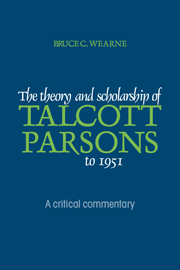Book contents
- Frontmatter
- Contents
- Preface
- Part 1 Unravelling Talcott Parsons' theoretical development
- Part 2 Talcott Parsons: the roots of his thought
- Part 3 The development of theory
- Part 4 The theory
- 7 Conceptualizing The Social System
- 8 Developing The Social System
- 9 Formulating The Social System
- 10 The Social System
- Part 5 Parsons' theory as it stood at 1951
- Appendix Some recent publishing on Talcott Parsons' theory: a bibliographical essay
- List of references
- Index of names
- Index of Parsonian concepts
7 - Conceptualizing The Social System
Published online by Cambridge University Press: 05 February 2012
- Frontmatter
- Contents
- Preface
- Part 1 Unravelling Talcott Parsons' theoretical development
- Part 2 Talcott Parsons: the roots of his thought
- Part 3 The development of theory
- Part 4 The theory
- 7 Conceptualizing The Social System
- 8 Developing The Social System
- 9 Formulating The Social System
- 10 The Social System
- Part 5 Parsons' theory as it stood at 1951
- Appendix Some recent publishing on Talcott Parsons' theory: a bibliographical essay
- List of references
- Index of names
- Index of Parsonian concepts
Summary
The long-term project
This and the following three chapters are the culminating chapters of this work. In this chapter the theory of action as it was stated in The Structure and in the unpublished document ‘Actor, Situation and Normative Pattern’ is presented. In the next chapter an overview of the development of the theory during the period 1937–51 is given. Chapter 9 looks closely at three formulations which were published during this time. Chapter 10 will provide a detailed statement of principles for the interpretation of The Social System by reference to the first two chapters of that work. This will be a critical summary. A full commentary of those chapters is not included here because of space constraint. Though this work is a critical commentary, a conventional secondary work, it seems that the ‘secondary literature’ on Parsons would be considerably strengthened by a line-by-line exegesis of The Social System on classical lines.
The conceptual scheme presented in The Structure was an outline only – ‘not yet worked out in detail’. That task remained. Towards the end of The Structure Parsons wrote,
It has repeatedly been stated that this study has not attempted a systematic treatment of what is, in this sense, the analytical aspect of the theory of action. It has been limited, rather, to working out the structural outline of the generalized systems of action to which such an analytical theory would be applicable.
(T. Parsons 1937a: 751)- Type
- Chapter
- Information
- The Theory and Scholarship of Talcott Parsons to 1951A Critical Commentary, pp. 91 - 115Publisher: Cambridge University PressPrint publication year: 1990



